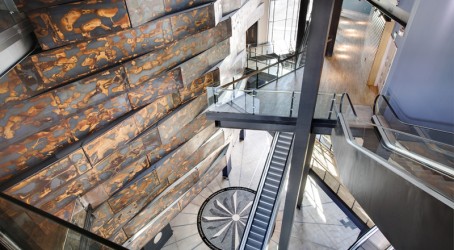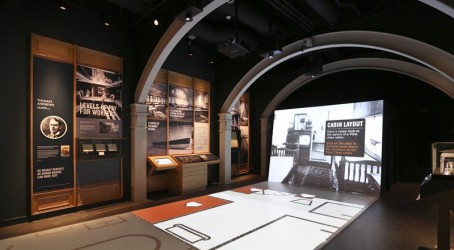In 1912, the Titanic sailed into history as one of the world’s deadliest peacetime maritime disasters. Located near the spot where the ship was built a century ago, the Titanic Belfast museum commemorates the catastrophe and celebrates the thousands of men and women who helped to build the great ships in Belfast.
In 1900, Harland & Wolff was the largest shipbuilding firm in the world and its site on Queen’s Island, Belfast, covered 80 acres and employed almost 10,000 people. Today the area is known as the Titanic Quarter, home to the new waterfront-regeneration project. Belfast’s skyline has been dominated since the 1960s by two giant Harland & Wolff gantry frames known as Samson and Goliath but now the pair have competition, as all eyes are on the new museum.
The shard-shaped structure is 38.5m tall and covers 14,000m2. Four enormous hulls, clad in thousands of aluminium plates, radiate out from a central glass structure. From a distance, the shimmering giant resembles a ship – it really is a visual treat.
Inside, the £97 million building continues to impress, with a soaring atrium which attempts to recall the awesome size of Titanic’s engine-rooms. It pierces up through five floors – you could be forgiven for thinking you’ve entered a lofty modern art gallery.

Nine galleries are spread across four angular levels of the museum. Each explores the Titanic story in a refreshingly fun and modern way: from conception in the early 1900s through to construction, the catastrophic maiden voyage and the discovery of the wreck.
Boomtown Belfast provides a fascinating overview of the city’s industry and workers during its prosperity and expansion period in the late 19th century. It is here that we are introduced to the Harland & Wolff, White Star Line and Cunard companies. An interactive floor shows off the grandiose construction plans for the Titanic, along with original drawings and scale models of the ship.
Meanwhile, the Building the Titanic exhibition looks at the five stages of the shipbuilding process: laying the keel, framing, plating and riveting, bulkheads and decking, and fitting the rudder. Nearby, there are queues for one of the museum’s top attractions – the “dark ride”. Visitors hop inside a cabin which glides around a mock-up of Titanic’s shipyard and a full-scale replica of the ship’s 23.7m-high rudder.
Titanic’s fit-out, which took 3,000 men more than 10 months to complete, is documented in the next gallery. The fit-out included boilers, engines, propellers, the Marconi wireless and navigation equipment. A central feature is a 360° computer-generated tour, which takes visitors on a journey through the decks – from the engine-room at the bottom to the dining saloons and the bridge on top. Replicas of first-, second- and third-class cabins offer a glimpse into the past.
There’s a distinct chill in the air in the Maiden Voyage gallery. Haunting SOS Morse code plays in the background, while moody lighting patterns the floor with ripples. Images of the sinking ship are paired with audio of survivors recounting their experiences.
A full-size replica of one of the lifeboats takes centre stage in the Finding the Answers exhibition. It’s a poignant reminder of just how insufficient the few small rescue boats were. Tributes are paid to the hundreds of passengers who lost their lives in the freezing ocean.
Titanic Beneath documents the quest to find the 52,000-ton wreck which was discovered in 1985, two-and-a-half miles below the surface of the North Atlantic. The gallery displays interviews and previously unseen footage. There’s also a glass floor where visitors can observe a mosaic of the Titanic as it rests on the seabed.
A last couple of surprises on the uppermost floors are not to be missed. There’s a full-sized reproduction of the Titanic’s grand staircase in one of the suites, while the high vantage point provides a panorama of the historic shipyards, river and Belfast city.

5 things to see
The interactive floor
Step across the construction plans and drawings for the Titanic.
The dark ride
This nine-minute ride offers a fun insight into the five stages of shipbuilding.
The 360º tour
Take this computer-generated tour which whisks visitors upwards through the Titanic’s magnificent decks.
The cinematic experience
Get up close and personal with the wreck of the Titanic – a mecca for treasure hunters
and tourists.
The panorama
Take the lift to the top floor to discover the beautiful views that Belfast has to offer.